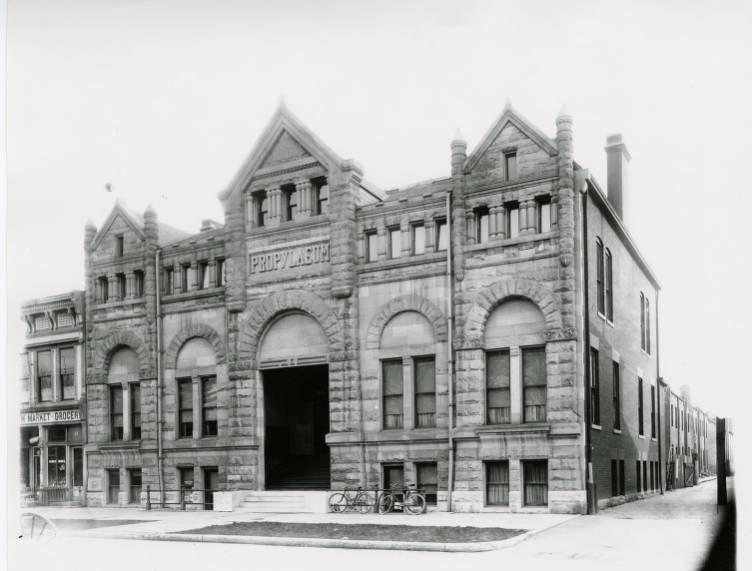The term Propylaeum refers to two buildings and an organization. A committee of seven women met on April 30, 1888, to find a suitable home for the . The chair, , proposed the formation of “a stock company for the purpose of erecting and owning a building.” The group selected the name Propylaeum from the Greek propylaea, or gateway, signifying that the organization would be the gateway to culture for Indianapolis.

The Indianapolis Propylaeum incorporated on June 6, 1888, with capital stock of $15,000. The Articles of Association provided that stock might be acquired, purchased, and held only by women. The articles specified that the building be used for “literary, artistic, scientific, industrial, musical, mechanical and education purposes” for the public, but particularly for the women of Indianapolis. Land was secured on North Street, east of Meridian Street, and the Propylaeum building was dedicated in 1891.
The Propylaeum became the key cultural meeting center for Indianapolis women and was home to many clubs, including the Indianapolis Woman’s Club, Fortnightly Literary Club, , , Daughters of the American Revolution, and the Portfolio Club. During World War I, the building housed numerous relief and recreation programs for soldiers and their families. The structure was razed in 1928 to make way for the .
With the impending loss of their property, the Propylaeum stockholders purchased the Schmidt-Schaf home at 1410 North Delaware Street in 1923. John W. Schmidt constructed the mansion in the newly fashionable neighborhood along North Delaware Street in 1891. The Joseph C. Schaf family occupied the house from 1904-1920. The Indiana College of Music and Fine Arts briefly occupied the building before the Propylaeum.
The Propylaeum has preserved the Victorian elegance of the Schmidt-Schaf house. A combination of Romanesque Revival and Queen Anne styles of architecture adorn the building. Notable features include the elaborate Romanesque arched entry, elegant bas-relief sculptures in terra cotta and stone, a large porte cochère with sandstone columns, wrought iron tree sculptures on the entry doors, Rookwood tile fireplace mantels, painted ceilings, Baroque style music room, Louis XV style drawing-room, and a grand staircase. The brick and stone carriage house contains a large reception space, office suites, and apartments. The Propylaeum was listed on the National Register of Historic Places in 1973.

After moving to their new home, members of the Propylaeum remodeled the mansion and carriage house to fit the organization’s needs. Walls were removed to create a large Club Room and additional bathrooms were installed, accommodating women living in the upstairs bedrooms. The former boiler house became a townhouse, in which resided for 35 years. The carriage house was transformed into an artist studio, which occupied for 30 years. The remaining stable space was reconfigured into two storefronts with an apartment above, housing over the years the , , and other arts organizations.
Under the leadership of , the Propylaeum redefined itself as an organization. Originally formed as a stock corporation only, members voted in 1923 to become a social club and operated as such through most of the 20th century. The Propylaeum continued to host arts and social events and remained the home of the Indianapolis Woman’s Club and other organizations. A Tea Room served lunch to members and their guests.
Recognizing the need for additional fundraising efforts to maintain the historic building, the Propylaeum Club created a nonprofit arm of the organization during the 1980s. The Propylaeum Historic Foundation brought attention to the home and oversaw the restoration of murals and decorative paint in the first-floor rooms. The Foundation expanded the history and legacy of the Propylaeum’s founder through the May Wright Sewall Leadership Award, recognizing outstanding leaders in the community.
In 2012, the club and foundation merged, forming a nonprofit organization serving women’s intellectual and cultural needs.

Help improve this entry
Contribute information, offer corrections, suggest images.
You can also recommend new entries related to this topic.